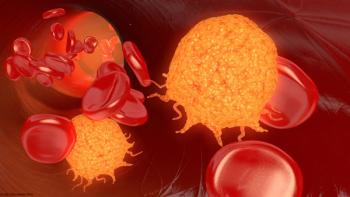
Oncology NEWS International
- Oncology NEWS International Vol 17 No 2
- Volume 17
- Issue 2
Mutational status affects nilotinib responses in CP-CML
In a significant proportion of imatinib (Gleevec)-resistant chronic-phase chronic myelogenous leukemia patients with Bcr-Abl mutations, nilotinib (Tasigna) treatment results in hematologic, cytogenetic, and molecular responses
ATLANTAIn a significant proportion of imatinib (Gleevec)-resistant chronic-phase chronic myelogenous leukemia patients with Bcr-Abl mutations, nilotinib (Tasigna) treatment results in hematologic, cytogenetic, and molecular responses, Timothy P. Hughes, MD, of the Hanson Institute, Adelaide, Australia, said at ASH 2007 (abstract 320).
Nilotinib is active against most Bcr-Abl mutations, with the exception of T3151.
The mutational analysis included 275 Philadelphia chromosome positive CP-CML patients: 68% imatinib resistant and 32% imatinib intolerant. Overall, 41% of patients had baseline Bcr-Abl mutations: 10% of imatinib-intolerant patients and 56% of imatinib-resistant patients.
Among baseline mutations, 13% were in less nilotinib-sensitive mutation groups (IC50 > 150 nM). Three percent in the T3151 group (IC50 > 10,000 nM) were excluded from analysis.
Reporting best responses at 12 months, Dr. Hughes said that clinical efficacy for nilotinib was seen in both the mutation and nonmutation groups. Responses were higher for patients with no mutation vs any mutation: Complete hematological responses (81% vs 71%), major cytogenetic responses (60% vs 50%), complete cytogenetic responses (CCyRs, 42% vs 32%), and major molecular responses (25% vs 21%).
Among patients with the less sensitive mutations, there were no CCyRs. On the other hand, response rates were comparable in patients without baseline mutations and with more sensitive mutations (IC50 ≤ 150 nM). Newly detectable mutations during therapy were found in 28% and 13% of imatinib-resistant patients with and without baseline mutations, respectively, and in 11% and 3%, respectively, of imatinib-intolerant patients.
Among 42 progressing patients, 31% had no baseline mutation, 33% had the same mutation as at baseline, and 36% had a newly detectable mutation.
Dr. Hughes concluded, "CP-CML patients without baseline mutations and those with mutations of IC50 ≤ 150 nM have similar response rates and progression with nilotinib while those with IC50 > 150 nM have lower response rates and higher risk of progression."
He commented that a larger data set and longer follow-up are needed to validate these findings.
Articles in this issue
almost 18 years ago
NLST article not balanced, critic of screening trial assertsalmost 18 years ago
M.D. Anderson and AstraZeneca form neuropathic pain alliancealmost 18 years ago
Good nilotinib responses in imatinib-resistant AP-CMLalmost 18 years ago
Virus linked to Merkel cell carcinomaalmost 18 years ago
Benefit of adjuvant RT/CT for pancreatic ca affirmedalmost 18 years ago
Recurrence Score helps select node+ pts for chemoalmost 18 years ago
For resectable liver mets: Preop chemotherapy or not?almost 18 years ago
Plerixafor boosts stem cell mobilization in myeloma ptsalmost 18 years ago
MRI shows second-hand smoke damagealmost 18 years ago
Assay has high sensitivity for hard-to-detect SLN metsNewsletter
Stay up to date on recent advances in the multidisciplinary approach to cancer.


















































































